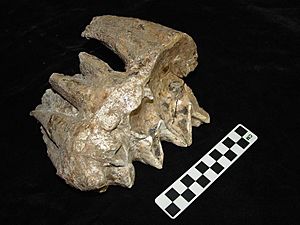Coats-Hines Site facts for kids
The Coats-Hines-Litchy site is a special place in Williamson County, Tennessee. It's where scientists found bones of ancient animals. For a while, people thought it was a site where early humans, called Paleoindians, hunted huge animals like mastodons during the last Ice Age. But later studies showed it's actually a natural collection of bones.
Scientists have found parts of four mastodon skeletons here. The findings from this site have been shared in science magazines. The Coats-Hines-Litchy site was added to the National Register of Historic Places on July 12, 2011. This means it's an important historical or scientific location.
What is the Coats-Hines-Litchy Site?
The Coats-Hines-Litchy site is located in Williamson County, Tennessee. It's near I-65. The site was first found in 1977. Workers were doing landscaping for a golf course when they saw some very large bones.
Scientists from the Tennessee Division of Archaeology carefully dug up some of these bones. They found part of a large female mastodon skeleton. This mastodon was called "mastodon A." The area where these bones were found was later destroyed by construction.
In 1994, more bones were found nearby. This was during construction of a new neighborhood. These bones were from the Ice Age. Scientists found bones from horses, deer, muskrat, and a young male mastodon. This mastodon was called "mastodon B." Another mastodon, "mastodon C," was also seen nearby but not dug up.
The site was named "Coats-Hines" after Patricia Coats, a scientist, and the Hines company. Later, in 2012, "Litchy" was added to the name. This was to honor the landowner. After the bones were studied, the area with mastodon B was covered up again. It is now part of a family's backyard.
Scientists kept watching the area. In 2008, they dug up more bones from mastodon C. These bones were very old and hard to identify. That same year, they found a stone tool and a piece of deer antler. These items had moved from their original spots. So, scientists couldn't be sure if they belonged with the ancient bones. However, the antler looked very old. This was exciting because Ice Age deer bones are rare in Tennessee.
In 2010, scientists got a grant to study the site more. They wanted to see if it should be on the National Register of Historic Places. They found many animal remains. These included bones from turtles, rodents, deer, and even small pieces of mastodon ivory and teeth. They also found 12 small stone flakes. These might have come from making stone tools. Two broken stone blades were also found. Based on these important finds, the site was added to the National Register on July 12, 2011.
In 2012, a team from Texas A&M University did a big study of the site. They looked at all the old findings again. They also dug up more areas. Their studies showed that the Coats-Hines-Litchy site is a natural collection of animal bones. It was not a place where humans hunted or lived. The bones were likely washed into the area by a river.
Was it a Paleoindian Hunting Site?
When mastodon B was first dug up in 1994, scientists found 34 stone items. These looked like stone tools or pieces from making tools. They were found near the mastodon bones. Some bones from mastodon B even had marks on them. These marks looked like they were made by cutting. Scientists thought these marks might have come from humans butchering the mastodon.
Scientists also used radiocarbon dating to find the age of the bones and dirt. The dates suggested the site could be very old. Some dates were even older than the time when the first known humans, called Clovis people, lived in North America. This made scientists wonder if even older humans had been there.
However, later studies changed this idea. Scientists looked at the stone pieces again. They found that these pieces did not clearly show signs of being made by humans. They might have been shaped by nature. The stone tools found earlier were either not tools at all or were found in places where they didn't belong with the mastodon bones. The "gravers" (tools for engraving) were actually natural rocks. The bone spear point was just a naturally broken bone.
New radiocarbon dating also showed that the bones were much older than when humans lived in Tennessee. The bones were from about 22,490 to 36,590 years ago. This is much earlier than when the first humans arrived in this part of America. Also, no one has re-examined the "cut marks" on mastodon B's bones since the first study.
Scientists now believe the area was once a shallow pond. Many animals, including mastodons, would have gathered there. The bones likely collected in the pond naturally. The latest studies show that the bones were deposited by a river. This means the site is a natural collection of ancient animal remains, not a place where early humans hunted mastodons.


